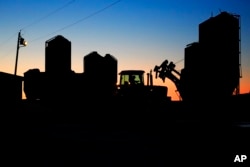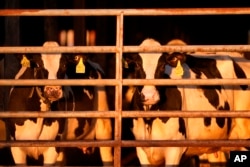Economic experts and business owners in the United States say immigrant workers have helped keep the country from falling into a recession.
Economists predicted the United States economy would suffer when the country’s central bank started raising the baseline rate for lending money about two years ago.
Instead, businesses have hired more workers. The unemployment rate has gone down. But rates have continued to rise.
The reason, experts say? People like Luisana Silva and Mariel Marrero, immigrants from Venezuela.
Silva, who is 25, lives in South Carolina and works for a rug company. She loads heavy carpets onto trucks for delivery. Silva, her husband and their 7-year-old daughter left Venezuela, walked through dangerous lands before arriving at the United States border city of Brownsville, Texas. They asked for asylum from the United States, claiming the need to escape political and economic difficulties at home.
Silva and her husband received work permits last year and found jobs. Silva earns enough to pay for a living space, buy food for her family, put fuel in her car and send money back to her parents in Venezuela. She wants to help her family back home and build a life for herself in the U.S.
Mariel Marrero, 32, left Venezuela in 2016 after receiving death threats for voicing opposition to President Nicolas Maduro. She lived in Panama and El Salvador before arriving in the U.S. and asking for asylum.
The U.S. is still considering her case. For now, Marrero has a short-term work permit. She lives in a small city outside of Miami, Florida, where many Venezuelan immigrants live. Marrero has worked several small jobs. She is now able to save about $200 each month to send to her family back in Venezuela.
Heidi Shierholz is president of the Economic Policy Institute in Washington, D.C. She is also a former chief economist at the U.S. Labor Department. She said economic observers considered it “something of a mystery” that the U.S. had strong job growth but also saw inflation drop while interest rates rose. Most believed the U.S. would see more unemployment.
“The immigration numbers being higher than what we had thought — that really does pretty much solve that puzzle,’’ Shierholz said.
Election issue
Still, immigration is set to be a central issue of this year’s U.S. presidential election.
Former President Donald Trump is the leading candidate opposing President Joe Biden in the race. He is criticizing Biden over what he believes is a lack of control at the southern U.S. border. Trump has described migrants as criminals and has said they are “poisoning the blood” of America. Trump says he wants to finish building the border wall that was a big part of his presidential campaign in 2016.
Wave of migration
Back in 2019, the Congressional Budget Office estimated net immigration – the number of new people minus those who left – would be about 1 million in the year 2023. The actual number turned out to be 3.3 million.
Many employers have welcomed the new arrivals.
When the United States ended some of its COVID-19 restrictions and businesses re-opened, business owners found a changed workforce. The number of native-born Americans in their “prime working years” – ages 25 to 54 -- had dropped. Many Americans had aged out of that group and were nearing retirement. This group’s numbers have shrunk by 770,000 since February 2020, just before COVID-19 hit.
But over the past four years, immigrants have filled that gap. The number of “prime-age” workers has increased by 2.8 million. Ninety-six percent of those workers were born outside the United States.
The Economic Policy Institute said immigrants accounted for almost 19 percent of the U.S. labor force in 2023. That is a record number.
Jan Gautam is the top leader of a hotel business in Orlando, Florida. He said most Americans do not want to take jobs cleaning hotel rooms in his company’s 44 hotels. He said 85 percent of his 3,500 employees are immigrants.
“Without employees, you are broken,” said Gautam, who is an immigrant from India.
In the northeastern American state of Maine, half of the workers at the Flood Brothers dairy farm are immigrants. Jenni Tilton-Flood is a partner in the farm. She said immigrant workers are skilled at feeding cows and collecting milk – almost 70,000 liters per day.
“We would not have an economy, in Maine or in the U.S., if we did not have highly skilled labor that comes from outside of this country,” Tilton-Flood said.
Wendy Edelberg and Tara Watson are economists at the Brookings Institution in Washington, D.C. They wrote in a study that over the past two years, immigrants permitted the U.S. to generate jobs without pushing inflation higher and causing a recession. They added that the U.S. can now absorb up to 200,000 new jobs per month without pushing up inflation.
In the past, economists said the number of new workers could not go higher than 100,000 per month without causing an inflation increase.
Douglas Holtz-Eakin once led the Congressional Budget Office. He said: “The way to solve an inflation crisis is to endure an immigration crisis.”
Observers agree that immigration as it stands in the United States can be difficult for state and local governments, even if it has helped the economy.
About 27 percent of the 3.3 million immigrants who came to the United States last year did so as “lawful permanent residents.” The rest – 2.4 million – either came without permission, overstayed their visas, are waiting for their cases to be heard in immigration court or are part of a program that lets them stay temporarily and sometimes work in the country.
Some experts say immigrants who come to the U.S. do important work that many Americans will not do. They are also likely to start new businesses.
While the experts debate what to do, Marrero, the Venezuelan immigrant living in Florida, said she feels lucky to be in the country.
“I imagine having my own company, my house, helping my family in a more comfortable way,” Marrero said.
I’m Caty Weaver. And I’m Dan Friedell.
Dan Friedell adapted this story for Learning English based on a report by the Associated Press.
______________________________________________
Words in This Story
baseline (interest)rate –n. the official money-lending rate banks charge each other; many other interest charges are based on this number
hire –v. to offer a person a job
rug –n. a floor covering made of fibers woven together
puzzle –n. a game played by fitting pieces together to form a shape or an image
retirement –n. the time when a person stops working or going to a job permanently
gap –n. a space between two things, such as a starting point and a destination
recession –n. a period of time where a country’s economy does not grow and in fact its output decreases slightly
absorb –v. to pick something wet up with a piece of fabric or a sponge
endure –v. to suffer through or undergo something difficult for a period of time
resident –n. a person who lives in a place, such as a city, country or neighborhood
We want to hear from you. Do you think the U.S. economy has room for more workers?














Forum